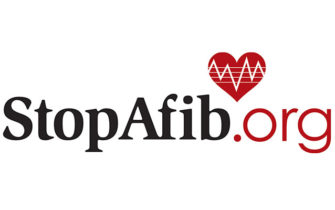
In the first of a series of articles highlighting CardioVisual’s valuable partners, we introduce you to StopAfib.org.
Former high-tech executive Mellanie True Hills was sitting at her desk in her home office one day when all of a sudden her heart “felt like it skipped some beats and took off racing.”
A rushed trip to the ER resulted in a diagnosis of atrial fibrillation, a condition she’d never heard of.
Because stroke is a major risk for patients with atrial fibrillation, Hills tried the standard treatment for stroke prevention, the drug Coumadin (the brand name for warfarin), but, for genetic reasons, she was never stable using that treatment. “I felt like a stroke walking around waiting to happen,” she says.
After 22 months of having afib, Hills elected for a minimally invasive surgical ablation (commonly called a “mini maze”), and she has been afib-free ever since.
“Once I was afib-free, I couldn’t stand on the sidelines and watch others suffer,” Hills says. So, in 2007, she started StopAfib.org, a non-profit organization that educates and supports atrial fibrillation patients and their family members.
In atrial fibrillation, the heart’s two small upper chambers (atria) don’t beat the way they should. Instead of beating in a normal pattern, the atria beat irregularly and often too quickly — sort of a quivering, or as she describes it: “like a fish flopping around in your chest.” Afib can lead to other life-threatening conditions such heart failure, in addition to stroke — and the risk of stroke is about five times higher in people with afib. This is because with afib blood can pool in the atria and blood clots can form; if these clots travel to the brain, a stroke may occur.
StopAfib.org’s website is packed with original and curated afib content describing the condition, explaining why it’s a problem, and offering dozens of additional resources for further study.
For example, the “Can it be Cured” section offers descriptions of treatment options, and is an invaluable resource for patients looking for solutions.
Another popular feature of the website is the “Patient Stories” section, where real people relay their experiences with afib. The site also features an afib-specialist finder and discussion forums where patients can share experiences and ask questions. A sister site, the Atrial Fibrillation Blog, is packed with even more heart-related news and information.
“As the creator of a tool that cardiologists use to easily educate their patients, CardioVisual is pleased to work with various partners who share the passion to help both patients and their healthcare providers,” says Manish Chauhan, MD FACC, founder of CardioVisual. “We are pleased to support Mellanie’s dedication and effort in bringing attention to atrial fibrillation and stroke reduction.”
Over the years, StopAfib.org’s scope has broadened as Hills and her team have partnered with major medical societies and patient organizations to raise awareness of afib and advocate for patients worldwide.
StopAfib.org, for example, hosts an annual Atrial Fibrillation patient conference. The conference brings together world-renowned afib researchers and physicians who share practical information and innovative research with conference attendees to help them manage their afib or find a solution.
And recently, StopAfib.org collaborated with the Alliance for Aging Research on their Year Without a Stroke campaign, an effort to share stories of people who have experienced and seen first-hand how serious AFib-related strokes can be. These people — patients, researchers and physicians — share the mission of educating patients and their loved ones about stroke risk and prevention.
Among StopAfib.org’s goals is to raise awareness of afib so “those who have it but don’t know it get diagnosed and treated before they have a stroke,” says Hills. It’s also important to her to “educate patients and their family members so they know how to best manage their afib.”
Ultimately, Hills says, “My vision is a stroke-free world.”